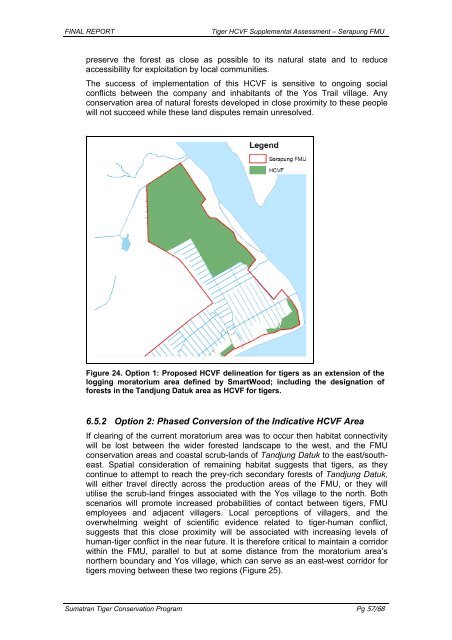A Supplemental HCVF Assessment on the Sumatran Tiger ...
A Supplemental HCVF Assessment on the Sumatran Tiger ...
A Supplemental HCVF Assessment on the Sumatran Tiger ...
You also want an ePaper? Increase the reach of your titles
YUMPU automatically turns print PDFs into web optimized ePapers that Google loves.
FINAL REPORT <strong>Tiger</strong> <str<strong>on</strong>g>HCVF</str<strong>on</strong>g> <str<strong>on</strong>g>Supplemental</str<strong>on</strong>g> <str<strong>on</strong>g>Assessment</str<strong>on</strong>g> – Serapung FMU<br />
preserve <strong>the</strong> forest as close as possible to its natural state and to reduce<br />
accessibility for exploitati<strong>on</strong> by local communities.<br />
The success of implementati<strong>on</strong> of this <str<strong>on</strong>g>HCVF</str<strong>on</strong>g> is sensitive to <strong>on</strong>going social<br />
c<strong>on</strong>flicts between <strong>the</strong> company and inhabitants of <strong>the</strong> Yos Trail village. Any<br />
c<strong>on</strong>servati<strong>on</strong> area of natural forests developed in close proximity to <strong>the</strong>se people<br />
will not succeed while <strong>the</strong>se land disputes remain unresolved.<br />
Figure 24. Opti<strong>on</strong> 1: Proposed <str<strong>on</strong>g>HCVF</str<strong>on</strong>g> delineati<strong>on</strong> for tigers as an extensi<strong>on</strong> of <strong>the</strong><br />
logging moratorium area defined by SmartWood; including <strong>the</strong> designati<strong>on</strong> of<br />
forests in <strong>the</strong> Tandjung Datuk area as <str<strong>on</strong>g>HCVF</str<strong>on</strong>g> for tigers.<br />
6.5.2 Opti<strong>on</strong> 2: Phased C<strong>on</strong>versi<strong>on</strong> of <strong>the</strong> Indicative <str<strong>on</strong>g>HCVF</str<strong>on</strong>g> Area<br />
If clearing of <strong>the</strong> current moratorium area was to occur <strong>the</strong>n habitat c<strong>on</strong>nectivity<br />
will be lost between <strong>the</strong> wider forested landscape to <strong>the</strong> west, and <strong>the</strong> FMU<br />
c<strong>on</strong>servati<strong>on</strong> areas and coastal scrub-lands of Tandjung Datuk to <strong>the</strong> east/sou<strong>the</strong>ast.<br />
Spatial c<strong>on</strong>siderati<strong>on</strong> of remaining habitat suggests that tigers, as <strong>the</strong>y<br />
c<strong>on</strong>tinue to attempt to reach <strong>the</strong> prey-rich sec<strong>on</strong>dary forests of Tandjung Datuk,<br />
will ei<strong>the</strong>r travel directly across <strong>the</strong> producti<strong>on</strong> areas of <strong>the</strong> FMU, or <strong>the</strong>y will<br />
utilise <strong>the</strong> scrub-land fringes associated with <strong>the</strong> Yos village to <strong>the</strong> north. Both<br />
scenarios will promote increased probabilities of c<strong>on</strong>tact between tigers, FMU<br />
employees and adjacent villagers. Local percepti<strong>on</strong>s of villagers, and <strong>the</strong><br />
overwhelming weight of scientific evidence related to tiger-human c<strong>on</strong>flict,<br />
suggests that this close proximity will be associated with increasing levels of<br />
human-tiger c<strong>on</strong>flict in <strong>the</strong> near future. It is <strong>the</strong>refore critical to maintain a corridor<br />
within <strong>the</strong> FMU, parallel to but at some distance from <strong>the</strong> moratorium area’s<br />
nor<strong>the</strong>rn boundary and Yos village, which can serve as an east-west corridor for<br />
tigers moving between <strong>the</strong>se two regi<strong>on</strong>s (Figure 25).<br />
<strong>Sumatran</strong> <strong>Tiger</strong> C<strong>on</strong>servati<strong>on</strong> Program Pg 57/68

















